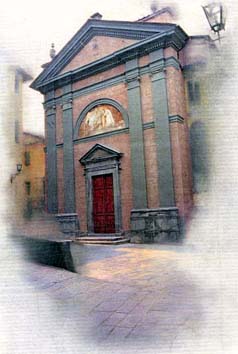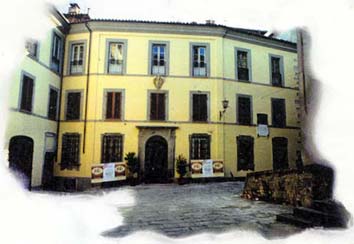|
Itinerary
n° 2: Porta Mancianella, Via di Mezzo and connecting passageways,
and Via della Speranza
This
walk starts again from the space in front of Porta
Mancianella and proceeds along the main road of the town, the Via
di Mezzo (Halfway Street). The name couldn't be more appropriate
as the street leads from one end of the historic part of the town
to the other, cutting it almost exactly in half. At the other end
of Via di Mezzo is the other entrance to the town, the Porta Macchiaia
(Gate of the Woods), so-called because it faces that part of the
Barga territory which is covered in the trees and shrubs of the
Appenines.
For
centuries these woods provided the lumber and charcoal for the people
of the town. Via
di Mezzo is also the street where you will find Barga's most elegant
squares and buildings. After passing several tall sombre houses,
which rarely see the sun, you come to a charming square, the Piazza
della Santissima Annunziata.
 |
|
The
square and church of Santissima Annunziata.
|
Here
you will find a beautiful Baroque church (17th-18th Cent.) which
is one of the more distinguished of the Barga churches and which
is well worth a visit. Inside are several interesting works of
art, including the altar painting by Baccio Ciarpi (1574-1654).
Ciarpi was originally from Barga but he worked in Rome and is
well known nationally. Also of interest is the group of wooden
statues representing the Annunciation. These statues are the work
of Tuscan masters and date back to the first decades of the 14th
Century.
Facing
the same square is the palazzo which belonged to the Mordini family.
The Mordini were important landowners in the past and many members
of the family became famous in public life in Barga and further
afield. One of these was Antonio Mordini, the leading light of
the Italian Risorgimento, whose monument, discussed previously,
stands on the bastions above the Fosso.
 |
| Palazzo
Mordini. |
In
this palazzo there is an archive of the letters, papers and documents
which Mordini collected throughout his life. According to the distinguished
historian and politician Giovanni Spadolini, this collection is,
as far as he knows, the most important one for the whole period
of the Risorgimento. The catalogue of the documents in this archive
is to be published soon under the auspices of the Ricci Foundation.
|